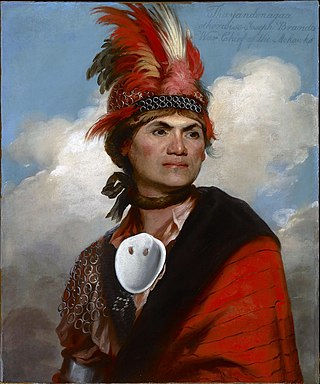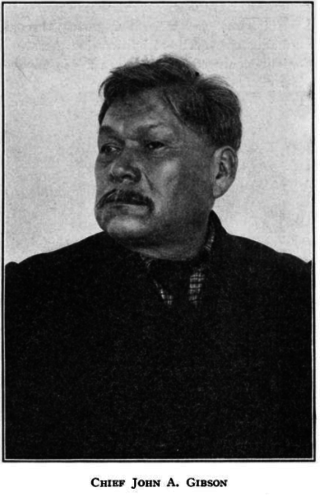Related Research Articles

Hiawatha, also known as Ayenwatha or Aiionwatha, was a precolonial Native American leader and cofounder of the Iroquois Confederacy. He was a leader of the Onondaga people, the Mohawk people, or both. According to some accounts, he was born an Onondaga but adopted into the Mohawks.

Among the Haudenosaunee the Great Law of Peace, also known as Gayanashagowa, is the oral constitution of the Iroquois Confederacy. The law was written on wampum belts, conceived by Dekanawidah, known as the Great Peacemaker, and his spokesman Hiawatha. The original five member nations ratified this constitution near modern-day Victor, New York, with the sixth nation being added in 1722.

Thayendanegea or Joseph Brant was a Mohawk military and political leader, based in present-day New York and, later, Brantford, in what is today Ontario, who was closely associated with Great Britain during and after the American Revolution. Perhaps the best known Native American of his generation, he met many of the most significant American and British people of the age, including both United States President George Washington and King George III of Great Britain.

The Kanien'kehá:ka are in the easternmost section of the Haudenosaunee, or Iroquois Confederacy. They are an Iroquoian-speaking Indigenous people of North America, with communities in southeastern Canada and northern New York State, primarily around Lake Ontario and the St. Lawrence River. As one of the five original members of the Iroquois League, the Mohawk are known as the Keepers of the Eastern Door – the traditional guardians of the Iroquois Confederation against invasions from the east. The Mohawk are federally recognized in the United States as the Saint Regis Mohawk Tribe.
The Seneca are a group of Indigenous Iroquoian-speaking people who historically lived south of Lake Ontario, one of the five Great Lakes in North America. Their nation was the farthest to the west within the Six Nations or Iroquois League (Haudenosaunee) in New York before the American Revolution. For this reason, they are called “The Keepers of the Western Door.”

The Onondaga people are one of the five original nations of the Haudenosaunee (Iroquois) Confederacy in the Northeastern Woodlands. Their historical homelands are in and around present-day Onondaga County, New York, south of Lake Ontario.

Six Nations is demographically the largest First Nations reserve in Canada. As of the end of 2017, it has a total of 27,276 members, 12,848 of whom live on the reserve. These nations are the Mohawk, Cayuga, Onondaga, Oneida, Seneca and Tuscarora. Some Lenape live in the territory as well.
The Covenant Chain was a series of alliances and treaties developed during the seventeenth century, primarily between the Iroquois Confederacy (Haudenosaunee) and the British colonies of North America, with other Native American tribes added. First met in the New York area at a time of violence and social instability for the colonies and Native Americans, the English and Iroquois councils and subsequent treaties were based on supporting peace and stability to preserve trade. They addressed issues of colonial settlement, and tried to suppress violence between the colonists and Indian tribes, as well as among the tribes, from New England to the Colony of Virginia.

The Treaty of Canandaigua, also known as the Pickering Treaty and the Calico Treaty, is a treaty signed after the American Revolutionary War between the Grand Council of the Six Nations and President George Washington representing the United States of America.
The Great Peacemaker, sometimes referred to as Deganawida or Tekanawí:ta was by tradition, along with Jigonhsasee and Hiawatha, the founder of the Haudenosaunee, commonly called the Iroquois Confederacy. This is a political and cultural union of six Iroquoian-speaking Native American tribes governing parts of the present-day state of New York, northern Pennsylvania, and the eastern portion of the provinces of Ontario, and Quebec Canada, recognized as sovereign by both the USA and Canada.

The Four Indian Kings or Four Kings of the New World were three Mohawk chiefs from one of the Five Nations of the Iroquois Confederacy and a Mohican of the Algonquian peoples, whose portraits were painted by John Verelst in London to commemorate their travel from New York in 1710 to meet Queen Anne of Great Britain. The three Mohawk were: Sa Ga Yeath Qua Pieth Tow of the Bear Clan, called King of Maquas, with the Christian name Peter Brant ; Ho Nee Yeath Taw No Row of the Wolf Clan, called King of Canajoharie, or John of Canajoharie; and Tee Yee Ho Ga Row, meaning "Double Life", of the Wolf Clan, also called Hendrick Tejonihokarawa or King Hendrick. The Mohican chief was Etow Oh Koam of the Turtle Clan, mistakenly identified in his portrait as Emperor of the Six Nations. The Algonquian-speaking Mohican people were not part of the Iroquois Confederacy. Five chiefs set out on the journey, but one died in mid-Atlantic.
"Bury the hatchet" is an American English idiom meaning "to make peace". The phrase is an allusion to the figurative or literal practice of putting away weapons at the cessation of hostilities among or by Native Americans in the Eastern United States.

The Haudenosuanee 'Tree of Peace' finds its roots in a man named [Dekanawida], the peace-giver. The legends surrounding his place amongst the [Iroquois] is based in his role in creating the Five Nations Confederacy, which consisted of the Mohawks, Oneidas, Onondagas, Cayugas, and Senecas, and his place as a cultural hero to the Haudenosaunee Nation, commonly known in Western culture as "Iroquois". The official title of the confederacy is, Kayanerenh-kowa as described by Paul A. Wallace, "it is also known as Kanonsionni, a term that describes both its geographical extent and its constitutional form". The myths and legends surrounding Dekanawida have the roots in the oral histories that followed many Native American tribes throughout their histories.

The Iroquois, also known as the Five Nations, and later as the Six Nations from 1722 onwards; alternatively referred to by the endonym Haudenosaunee are an Iroquoian-speaking confederacy of Native Americans and First Nations peoples in northeast North America. They were known by the French during the colonial years as the Iroquois League, and later as the Iroquois Confederacy, while the English simply called them the "Five Nations". The peoples of the Iroquois included the Mohawk, Oneida, Onondaga, Cayuga, and Seneca. After 1722, the Iroquoian-speaking Tuscarora people from the southeast were accepted into the confederacy, from which point it was known as the "Six Nations".
John Skenandoa, also called Shenandoah among other forms, was an elected chief of the Oneida. He was born into the Iroquoian-speaking Susquehannocks, but was adopted into the Oneida of the Iroquois Confederacy. When he later accepted Christianity, he was baptized as "John", taking his Oneida name Skenandoa as his surname. Based on a possible reconstruction of his name in its original Oneida, he is sometimes called "Oskanondonha" in modern scholarship. His tombstone bears the spelling Schenando.

Tadodaho was a Native American Hoyenah (sachem) of the Onondaga nation before the Deganawidah and Hiawatha formed the Iroquois League. According to oral tradition, he had extraordinary characteristics and was widely feared, but he was persuaded to support the confederacy of the Five Nations.

The Tree of Peace Society was founded in 1984 and incorporated in New York State on October 17, 1994, as a "foreign" not-for-profit corporation. Its headquarters are located on the Akwesasne Mohawk reservation in Hogansburg, New York, which borders the provinces of Quebec and Ontario, Canada, along the St. Lawrence River.

John Arthur Gibson (1850–1912) was a chief of the Seneca nation of the North American Iroquois confederation. Part Onondaga and part Seneca, he resided within the reserve of the Six Nations of the Grand River in Ontario, Canada. Knowledgeable about Iroquois (Haudosaunee) culture, he is best known for the versions he provided of the Iroquois oral constitution, the Great Law of Peace. He acted as an advisor to the Canadian Department of Indian Affairs in matters relating both to Iroquois and non-Iroquois indigenous people. He was a well-respected player of the traditional Iroquois sport of lacrosse until he was blinded during a game when he was 31.

The flag of the Iroquois Confederacy or Haudenosaunee flag is the flag used to represent the six nations of the Iroquois. It is a purple flag with four connected white squares and an eastern white pine tree in the center.

The Royaner are the hereditary male clan leaders within the Haudenosaunee Confederacy. They are chosen by their respective Yakoyaner to represent their clan at the confederacy level. The specific name-titles held by the royaner belong to the matrilineal lineages headed by the clan mothers. These male leaders are expected to serve their community for life, although there are ways of removing a royaner if he does not live up to his lineage's expectations. With the clan mothers, the royaner form the hereditary leadership that distinguishes itself from the elected Band Council imposed by the Canadian state.
References
- ↑ "Speech of the Mohawks to the Magistrates and Committee of Schenectady, and the Mayor and Committee of Albany, delivered by Little Abraham, May 20 | Northern Illinois University Digital Library". digital.lib.niu.edu. Retrieved 2023-07-17.
- 1 2 3 Pastore, Ralph T. (1979). "TEIORHÉÑHSEREˀ". Dictionary of Canadian Biography, vol. 4. University of Toronto/Université Laval. Retrieved 2023-07-17.
- 1 2 Fitz, Caitlin A. (2008). ""Suspected on Both Sides": Little Abraham, Iroquois Neutrality, and the American Revolution". Journal of the Early Republic. 28 (3): 299–335. ISSN 0275-1275.
- ↑ Communications. "Government". Haudenosaunee Confederacy. Retrieved 2023-07-17.